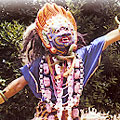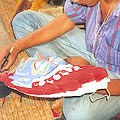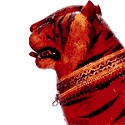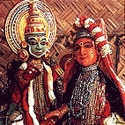Brightly painted ritual masks worn during religious ceremonies and processions in Nepal are made of perishable materials such as papier mache and wood, plastered with clay and linen. The art of making these masks is alive and alive and vibrant; age-old tradition dictates the use of new masks for religious processions and ceremonies and the ritual destruction of masks that have already been put to use. Masks have played an important role in the observation of social and religious traditions in Nepal – and the part they play is both symbolic and self-explanatory to the worshipper and the spectator.
In Nepal, masks are used almost exclusively in religious processions and functions; unlike in other parts of the world they are not used as part of theatrical and commercial performances. In the last few decades the crafting of these ritual masks has received a huge boost and their marketing has been greatly commercialised due to the interest evinced in them by the tourists and the export market.
TRADITIONS & CLASSIFICATIONS
Broadly speaking, the masks representing gods, goddesses, demons, and animals can be classified into four main categories.
- Masks that represent gods and are worn by humans.
- Ornamental masks that are used in temples in observance of religious rituals.
- Masks that are used in processions while celebrating festivals and jatras.
- Masks that are made especially for the tourist trade.

The first three categories adhere to strict rules of iconography and iconometry. These masks – representing gods, goddesses, and demons are endowed with their own attributes and are cast according to the ritual or scene that is to be worshipped or depicted, thereby resulting in immediate identification by the worshipper. As these masks represent images of deities that are worshipped, they need to be constructed very carefully – even the colours used carry their own message(s) and significance. For instance, red is associated with animal sacrifices and anger, blue-black with energy and power, and white with purity and death. The mask is only one part of the ensemble; the dancers must also wear the appropriate clothes and ornaments, which, along with the mount, motifs, the mukuta (crown), and accessories, are also represented with their exact attributes. Masks are not only distinguished from each other by their forms and by their colours but also by their very distinctive and individual head-gears.
Besides representing gods, goddesses and demons the masks also include representation of tigers, bears, lions and other animals. And all the dancers who wear masks are men The processions on the occasion of the major festivals are important parts of the proceedings.

The dances of the nava-durga in all localities of the Kathmandu Valley are linked with the agricultural cycle, and in particular with rice production. The masked dances cease during the monsoon. The masks used in Bhaktapur and at Kathmandu are ritually destroyed with fire before the monsoon starts; they ‘come to life’ or are re-made in the month of September, during the festival of Dussehra. The exception to this rule are the masks of the nava-durga dancers at Theco, formerly a part of the kingdom of Patan: these are not destroyed annually after the troupe’s performance, but are instead repaired, re-plastered, and re-painted every year and stored in the temple. Every 12 years, however, at the time of the major festival of Theco, new masks are made and the old masks; the old masks are not destroyed but now stored in the attic of the local temple.
PRACTITIONERS & CRAFT LOCATIONS
The masks made traditionally as well as in contemporary times, are made by members of the Newar chitrakar community of painter. The painters follow the rules of iconography very carefully or else the masks cannot be consecrated, and subsequently cannot be used for religious purposes. The chitrakars pass through a religious initiation (diksha) before they can employ their training in the making of ritual masks.
Thimu and Bhaktapur are the main centres for crafting masks that are used in ritual masked dances and processions.

PROCESS & TECHNIQUE
For religious and ritual masks, strict rules of iconography have to be adhered to. For each deity, the exact proportions, colours, symbols, and mukuta (crown/diadem) are laid down. Reference folding books – containing details of the dimensions, colours, and attributes for the images of the different gods and goddesses – are available to chitrakars, and are followed scrupulously. It is believed that if the rules of iconography are not followed a benevolent deity can become a demoniac force; therefore a painter cannot break any rules while depicting a religious image. A in existence a number of folding books of iconographic drawings are still available, the earliest one dating from the first half of the fifteenth century.
As these masks are ritually destroyed after use – and thus need to be continuously renewed and remade – tradition dictates that the new masks contain a bit of the old as well. Therefore, in the months of April and May, on the day of sithinaka, when ponds and wells throughout the Kathmandu Valley are cleansed, the old masks are burnt; and most of the ashes are cremated, some proportion is used in the new masks, thereby creating a link with the past – a sense of continuity. The ritual mask painting is done in the month of August/September, one month before the Dussehra festival.
The masks are made of clay mixed with bits of cotton and a locally made gum paste made from wheat flour. This mixture is prepared by the painter and then separated into 13 parts. Each part is placed over a low-relief mould which is covered with a clean black cloth – the painters presses the flattened clay with his fingers so that it takes on the contours of the mould. The clay mask forms are left to dry on the moulds for about four days. After they are removed from the moulds, the masks are painted with a mixture of boiled wheat-flour, water, and animal glue; this dries to a semi-opaque finish. Previously, the chitrakars used vegetable and mineral colours to paint the mask; now, however, it is chemical colours that are predominantly used.
A CONTEMPORARY PERSPECTIVE
In the past two decades, many commercial artists in the Kathmandu Valley have started making masks for the tourist and export trade. Stores all over the Valley sell these masks, either as wall hangings or as puppets. Though not as beautiful and carefully constructed as the ritual masks, the masks made for commercial purposes are well-appreciated and have markets all over the world. The masks are sold in shops in Kathmandu, Patan, and Bhaktapur.
Gallery
YOUR VIEWS
PRACTITIONERS: INDIA
Access 70,000+ practitioners in 2500+ crafts across India.
BIBLIOGRAPHY
10,000+ listings on arts, crafts, design, heritage, culture etc.
GLOSSARY
Rich and often unfamiliar vocabulary of crafts and textiles.
SHOP at India InCH
Needs to be written.





